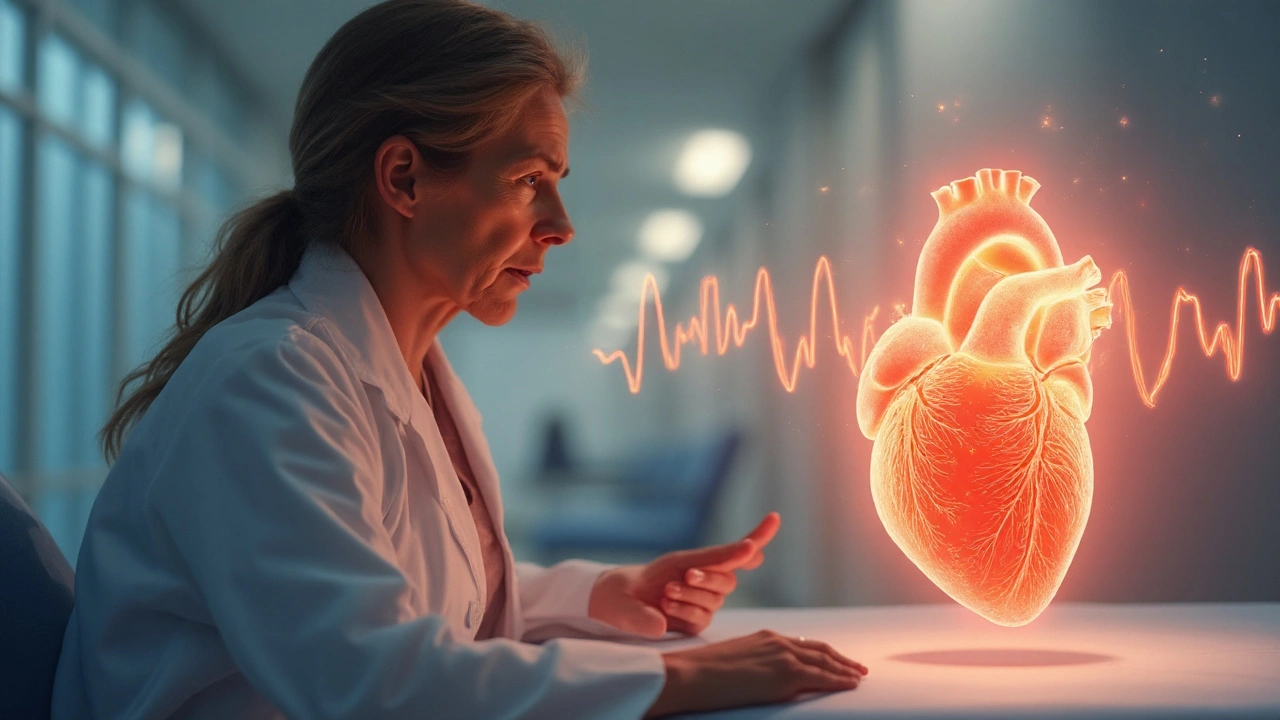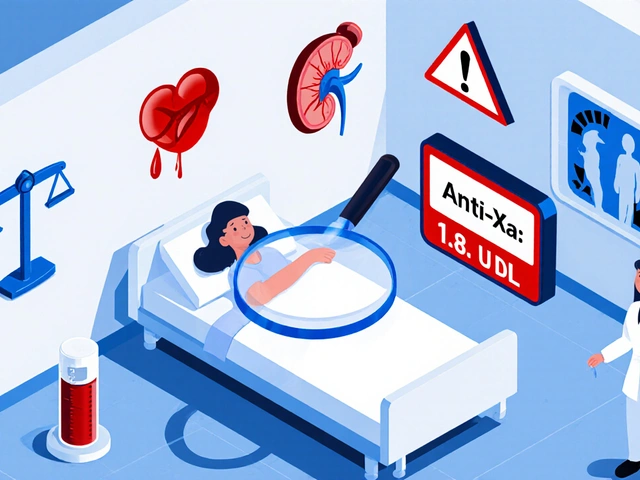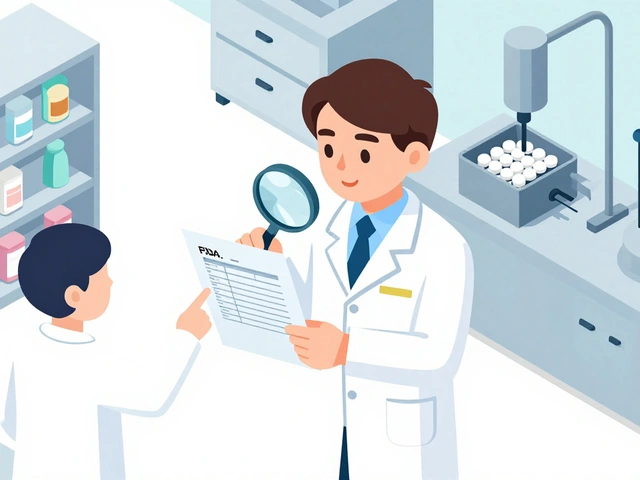Atrial Fibrillation & Thyroid Disorders: Understanding the Link

Atrial Fibrillation is a common cardiac arrhythmia marked by irregular, rapid atrial contractions that can lead to stroke, heart failure, and reduced quality of life. When you hear the term, you probably picture a racing heartbeat or a fluttering sensation. What many don’t realize is that the thyroid gland, a small butterfly‑shaped organ in the neck, can push the heart into that chaotic rhythm.
Thyroid Disorders are conditions that disrupt the production of thyroid hormones (thyroxine (T4) and triiodothyronine (T3)), which regulate metabolism, temperature, and heart function. The two ends of the spectrum-Hyperthyroidism (excess hormone) and Hypothyroidism (deficient hormone)-have distinct but overlapping effects on cardiac electrophysiology.
Why Thyroid Hormones Matter for the Heart
Thyroid hormones bind to receptors in cardiac myocytes, boosting the expression of ion channels that control the flow of sodium, calcium, and potassium. More channels mean faster depolarization, shorter refractory periods, and a higher chance that premature beats trigger atrial fibrillation. The result is a heart that’s primed to beat erratically.
Conversely, low hormone levels slow conduction, raise systemic vascular resistance, and can cause diastolic dysfunction. While less likely to spark AF directly, hypothyroidism can create a substrate where atrial enlargement and fibrosis develop over time, setting the stage for later arrhythmias.
Hyperthyroidism: The Fast‑Track to A‑Fib
People with untreated hyperthyroidism face a 10‑fold increase in AF risk compared with euthyroid adults. The classic triad-weight loss, tremor, and palpitations-often masks the underlying rhythm problem.
Beta‑Blockers are drugs that blunt the heart’s response to excess thyroid hormone by blocking adrenergic stimulation, thereby lowering heart rate and reducing arrhythmic triggers. They’re a first‑line bridge while definitive therapy (antithyroid meds, radioactive iodine, or surgery) takes effect.
Real‑world example: a 58‑year‑old woman diagnosed with Graves’ disease presented with a rapid irregular pulse during a routine exam. Lab work confirmed a free T4 of 3.5ng/dL (normal<1.8) and suppressed TSH. After a short course of propranolol and methimazole, her rhythm converted back to normal sinus within two weeks.
Hypothyroidism: A Subtle Contributor
Even mild hypothyroidism can raise atrial pressure and promote atrial enlargement. The slowdown in metabolic rate also leads to higher cholesterol, increasing atherosclerotic burden that indirectly stresses the heart.
Levothyroxine is a synthetic form of thyroxine used to restore normal hormone levels, which in turn can improve diastolic filling and reduce atrial stretch. Dosage is titrated based on TSH, aiming for the reference range of 0.4‑4.0µIU/mL.
Case in point: a 72‑year‑old man with longstanding hypothyroidism and occasional palpitations was found to have episodes of AF on a 24‑hour Holter monitor. After adjusting his levothyroxine dose to achieve a TSH of 1.2µIU/mL, his AF burden dropped from 8% to less than 1% over three months.
Clinical Evaluation: Connecting the Dots
When a patient presents with irregular heartbeats, clinicians should always check thyroid function. A basic panel includes TSH, free T4, and sometimes free T3. The Electrocardiogram (ECG) captures the rhythm, showing characteristic "irregularly irregular" QRS complexes in AF and often a shortened PR interval in hyperthyroid states.
Additional tools:
- Transthoracic echocardiogram to assess left atrial size and ejection fraction.
- Continuous cardiac monitoring (Holter or event recorder) for paroxysmal episodes.
- Thyroid antibodies (TSI, TPO) to differentiate autoimmune etiologies.
Management Strategy: Treat the Thyroid, Treat the Rhythm
The cornerstone is correcting the hormone imbalance. For hyperthyroid patients, the sequence often looks like this:
- Start a beta‑blocker to control rate.
- Initiate antithyroid medication (methimazole) or schedule radioactive iodine.
- Re‑evaluate rhythm after thyroid levels normalize; consider cardioversion if AF persists.
For hypothyroid patients, the steps are:
- Adjust levothyroxine dose to achieve target TSH.
- Monitor heart rate; if bradycardia or low-output symptoms develop, consider adding a low‑dose rate‑controlling agent.
- If AF remains despite euthyroid status, follow standard AF guidelines (anticoagulation, rhythm control).
Anticoagulation decisions follow the CHA₂DS₂‑VASc score, independent of thyroid status. The CHA₂DS₂‑VASc assigns points for congestive heart failure, hypertension, age, diabetes, stroke history, vascular disease, and sex, guiding the use of oral anticoagulants.

Comparison of Thyroid‑Related AF Risk
| Aspect | Hyperthyroidism | Hypothyroidism |
|---|---|---|
| Typical Hormone Levels | Elevated T3/T4, suppressed TSH | Low T3/T4, elevated TSH |
| AF Incidence | ~10% of untreated patients | ~2‑4% (often with comorbidities) |
| Primary Mechanism | Increased automaticity, shortened refractory period | Atrial enlargement, fibrosis, slowed conduction |
| First‑Line Rate Control | Beta‑blocker (e.g., propranolol) | Often none; focus on thyroid normalization |
| Definitive Therapy | Antithyroid drugs, radioactive iodine, or surgery | Levothyroxine titration |
When to Seek Immediate Care
If you experience sudden palpitations, chest tightness, shortness of breath, or fainting, treat it as an emergency. These symptoms can signal a rapid‑ventricular response or a stroke‑causing clot.
For patients already diagnosed with a thyroid disorder, regular follow‑up is crucial. A shift in TSH by more than 50% from baseline should trigger a repeat ECG, even if you feel fine.
Connecting the Dots: Related Topics to Explore
Understanding the thyroid‑AF link opens doors to broader discussions. You might want to read about:
- Cardiac effects of other endocrine disorders (e.g., diabetes, adrenal disease).
- Latest ACC/AHA Guideline recommendations for AF management in patients with comorbidities.
- Risk stratification tools like HAS‑BLED for bleeding risk while on anticoagulants.
Key Takeaways
Thyroid hormones wield powerful control over heart rhythm. Hyperthyroidism can thrust the heart into a fast, irregular beat, while even mild hypothyroidism can lay the groundwork for later arrhythmias. By checking thyroid labs early, treating hormone imbalances promptly, and following standard AF protocols, clinicians can dramatically cut the risk of stroke and improve quality of life.
Frequently Asked Questions
Can a normal thyroid function test still be linked to atrial fibrillation?
Yes. Subclinical hyperthyroidism-where TSH is low but T3/T4 are within normal limits-still raises the chance of AF by up to 3‑fold. Clinicians often repeat testing if AF appears without an obvious cause.
Is beta‑blocker therapy enough to stop AF in hyperthyroid patients?
Beta‑blockers control the heart rate but rarely convert AF to sinus rhythm on their own. They buy time while antithyroid treatment normalizes hormone levels, after which many patients revert to normal rhythm.
Should hypothyroid patients on levothyroxine be anticoagulated automatically?
Anticoagulation depends on the CHA₂DS₂‑VASc score, not on thyroid status alone. If the score is 2 or higher (men) or 3 (women), oral anticoagulants are recommended regardless of thyroid disease.
How quickly does AF resolve after treating hyperthyroidism?
Most patients see rhythm improvement within 4‑6weeks of achieving euthyroid status. Some may need cardioversion if AF persists beyond three months.
What lifestyle changes help lower AF risk in thyroid disease?
Maintain a stable weight, limit caffeine and alcohol, ensure adequate sleep, and manage stress. Regular physical activity improves cardiovascular fitness, which dampens the arrhythmic trigger of hormone swings.






Comments (15)
Gareth Pugh
24 Sep 2025
Thyroid hormones act like a turbo‑charger for heart cells, cranking up the sodium and calcium channels so the atria fire off too fast.
Illiana Durbin
25 Sep 2025
When you’re dealing with hyperthyroidism, the extra T3 and T4 essentially lower the threshold for ectopic beats, which is why palpitations often accompany weight loss and tremor.
Tyler Heafner
26 Sep 2025
Indeed, the pathophysiology is well documented in the literature; excess catecholamine sensitivity coupled with up‑regulated β‑adrenergic receptors precipitates atrial ectopy.
anshu vijaywergiya
27 Sep 2025
The heart’s rhythm is a delicate dance, and an over‑enthusiastic thyroid swoops in like an over‑eager partner, twirling the atria into a chaotic waltz.
ADam Hargrave
28 Sep 2025
Wow, another American‑made “miracle cure” for AF – just sprinkle some patriotism on your thyroid meds and hope for the best 😂.
Michael Daun
29 Sep 2025
looks solid
Rohit Poroli
30 Sep 2025
From an electrophysiological perspective, thyroid‑mediated upregulation of HCN channels accelerates pacemaker currents, while altered expression of connexin‑43 disrupts atrial conduction velocity, jointly fostering a substrate conducive to re‑entry circuits.
William Goodwin
1 Oct 2025
🔥🔥 Thyroid storms can turn a calm heart into a fireworks show! 🌟 Grab a beta‑blocker, keep that pulse in check, and don’t let the hormones run the party. 🎉
Isha Bansal
2 Oct 2025
The interplay between endocrine function and cardiac electrophysiology is not merely a footnote in textbooks; it represents a fundamental axis that dictates arrhythmic risk across a spectrum of clinical scenarios. Hyperthyroidism, by virtue of its catabolic surge, amplifies basal metabolic rate and inevitably escalates sympathetic tone, thereby lowering the refractory period of atrial myocytes. This shortening of refractory periods creates multiple windows of vulnerability where premature atrial contractions can trigger re‑entrant circuits. Moreover, thyroid hormones up‑regulate the expression of voltage‑gated sodium channels, further hastening depolarization velocity. In contrast, hypothyroidism, though less overtly arrhythmogenic, promotes myocardial fibrosis through chronic low‑grade inflammation and endothelial dysfunction, establishing a substrate for delayed after‑depolarizations. The resultant atrial dilation and structural remodeling serve as a silent prelude to atrial fibrillation that may manifest only years later. Clinically, this dichotomy underscores the necessity of regular thyroid function monitoring in patients with unexplained AF, especially when conventional risk factors are absent. Therapeutically, beta‑blockers remain a cornerstone for rate control, yet definitive management of the underlying thyroid disorder-be it antithyroid drugs, radioactive iodine, or surgical thyroidectomy-provides the most durable solution. It is also worth noting that subclinical hyperthyroidism can be a hidden driver of paroxysmal AF, often escaping detection without a high index of suspicion. Therefore, a comprehensive approach that integrates endocrinology and cardiology perspectives yields the best outcomes for patients navigating this complex interplay.
Blair Robertshaw
3 Oct 2025
Looks like the author just copied Wikipedia.
rama andika
4 Oct 2025
Oh sure, because the government is definitely hiding a massive conspiracy of thyroid‑induced AF to keep us all under control. 🙄
Kenny ANTOINE-EDOUARD
5 Oct 2025
Beta‑blockers act as a physiological “brake” on the sympathetic surge caused by excess thyroid hormones, effectively damping the premature atrial beats that precipitate AF.
Craig Jordan
6 Oct 2025
While many celebrate the clear link between hyperthyroidism and atrial fibrillation, one must not overlook the substantial body of evidence suggesting that subclinical variations in thyroid function may be merely epiphenomena, not causative agents. The epidemiological data are riddled with confounders-age, obesity, hypertension-that muddy any direct causation claim. Moreover, the reliance on serum TSH alone ignores the nuanced tissue-level sensitivity to thyroid hormone, which can vary dramatically between individuals. To assert a simplistic one‑to‑one relationship is to ignoring the complex neuro‑hormonal feedback loops that govern cardiac excitability. In short, the narrative is far more intricate than a headline‑grabbing “thyroid causes AF” sound bite.
Jessica Wheeler
7 Oct 2025
Honestly, if you don’t check your thyroid, you’re just neglecting basic medical responsibility.
Mikayla Blum
8 Oct 2025
The take‑away is simple: treat the thyroid, and the heart will thank you. 😊